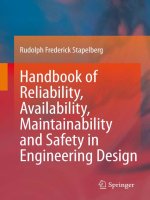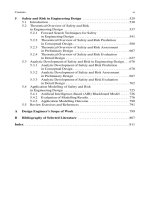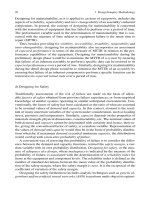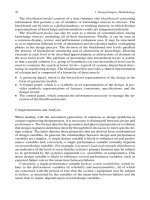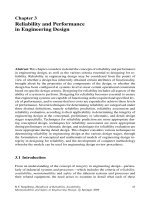Handbook of Reliability, Availability, Maintainability and Safety in Engineering Design - Part 83 ppsx
Bạn đang xem bản rút gọn của tài liệu. Xem và tải ngay bản đầy đủ của tài liệu tại đây (70.57 KB, 10 trang )
804 A Design Engineer’s Scope of Work
Procurement
• Develop procurement policies and procedures.
• Issue & evaluate bids for major equipment items and sub-contracts.
• Develop installed equipment costs.
• List suitable vendors for key equipment.
• Identify long-lead items.
Development of Capital and Operating Cost
The capital and operating cost estimates will be developedinto a format to be agreed
by the owner. The estimates will be developed to an accuracy of ±10%.
Development of the Project Schedule
• The master schedule will be developed for the project.
• The format and level of detail to be included is to be agreed by the owner.
• The master schedule must reflect the following:
– Fabrication/installation schedules.
– Vendor baseline commitments.
– Construction schedules.
– Commissioning schedules.
Va lue Engineering and Risk Assessment
The contractor will ensure that during the definitive study phase, engineering effort
is directed at minimising the cost of the EPC phase of the project without intro-
ducing unacceptable risk. As part of this requirement, a full risk assessment will be
undertaken on the project to ensure that all risks have been adequately identified
and quantified. Significant effort will be put into the p lanning of the project deliv-
ery to ensure the best approach. The constructability of the plant and such issues as
onsite or offsite pre-assembly of structures and vessels will be assessed for the im-
pact on overall cost and schedule. During engineering, discussions will be held with
the owner to look at ways to optimise the design especially the full utilisation of
services and utilities. Commonality of designs will be considered to reduce spares
inventories, and prior studies will be reviewed and incorporated where appropriate.
A Design Engineer’s Scope of Work 805
Project Execution Plan
A project execution plan will be prepared that includes the following sub-plans as
a minimum:
• Occupational health and safety p lan.
• Contracting plan.
• Industrial relation plan.
• Procurement plan.
• Human resources plan.
• Quality assurance plan.
• Automation plan.
• Procedures for the implementation phase of the project.
General
All work during the course of the definitive study is to be completed in accordance
with procedures to be developed by the contractor and approved by the owner. The
contractor will make suitable office facilities available for the owner’s entire project
team including office accommodation and general office administration and IT sup-
port. The contractor is to provide progressive reporting on the progress of the pro-
gram together with cost and schedule status.
Final Report
The contractor will be responsible for the preparation of the final study report. This
is to include preparation, compilation, review & editing, and final issue. The con-
tractor will also be responsible for incorporating the owner’s contributions into the
full report where relevant. The format and content of the final report will be devel-
oped by the contractor and approved by the owner.
This report will include:
• A written description of the plant and all of its sub-facilities.
• A written descriptio n of the services provided.
• A written description of the major equipment required for each area of the plant.
• All the information produced as part of the services.
Ten copies of the final report (bound) are to be made available to the owner on com-
pletion, together with a computer hard disk drive containing the complete report,
all o f the study deliverables and all of the information/calculations, etc. used to de-
velop the study deliverables. All information is to be appropriately logged to ensure
its rapid retrieval if required.
Appendix B
Bibliography of Selected Literature
References [ ] = handbook chapter number
Ajmone Marsan M, Balbo G, Conte G, Donatelli S, Franceschinis G (1995) Modelling with gen-
eralised stochastic Petri nets. Wiley, Chichester, NY [4]
Aslaksen E, Belcher R (1992) Systems engineering. Prentice Hall of Australia [3]
Barnett V (1973) Comparative statistical inference. Wiley, Chichester, NY [3]
Beaumont GP (1986) Probability and random variables. Ellis Horwood, New York [5]
Bellman RE, Dreyfus E (1962) Appl ied dynamic programming. Princeton University Press, Pri nce-
ton, NJ [5]
Bing G (1996) Due diligence techniques and analysis: critical questions for business decisions.
Quorum Books, Westport, CT [4]
Blanchard BS, Fabryck y WJ (1990) Systems engineering and analysis. Prentice Hall, Englewood
Cliffs, NJ [3]
Blanchard BS, Verma D, Peterson EL (1995) Maintainability: a key to effective serviceability and
maintenance management. Prentice Hall, Englewood Cliffs, NJ [4]
Box GEP, Hunter WG, Hunter JS (1978) Statistics for e xperiments. Wiley, Chichester, NY [4]
Buchanan BG, Shortliffe EH (1984) Rule-based expert systems. Addison-Wesley, Reading, MA
[3]
Bulgren WG (1982) Discrete system simulation. Prentice Hall, Englewood Cliffs, NJ [4]
Bussey LE (1978) The economic analysis of industrial projects. International Series in Industrial
and Systems Engineering. Prentice Hall, Englewood Cliffs, NJ [4]
Carter ADS (1986) Mechanical reliability, 2nd edn. Macmillan Pr es s, London [3]
Carter ADS (1997) Mechanical reliability and design. Macmillan Press, London [3]
Casti J (1979) Connectivity, complexity, and catastrophe in large-scale systems. International Se-
ries on Applied Systems Analysis. Wiley, Chichester, NY [4]
Casti J (1994) Complexification. Harper Collins, New York [4]
Cheremisinoff NP (1984) Fluid flow. Gulf, Houston, TX [4]
Dhillon BS (1983) Reliability engineering in systems design and operation. Van Nostrand Rein-
hold, Berkshire [3, 4, 5]
Dhillon BS (1999a) Design reliability: fundamentals a nd applications. CRC Press, LLC 2000, NW
Florida [3]
Dhillon BS (1999b) Engineering maintainability. Gulf, Houston, TX [4]
Dubois D, Prade H (1988) Possibility theory—an approach to computerized processing of uncer-
tainty. Plenum Press, New York [3]
Dubois D, Prade H, Yager RR (1993) Readings in fuzzy sets and intelligent systems. Morgan
Kaufmann, San Mateo, CA [3]
Elsayed EA (1996) Reliability engineering. Addison-Wesley Longman, Reading, MA [4]
R.F. Stapelberg, Handbook of Reliability, Availability, 807
Maintainability and Safety in Engineering Design,
c
Springer 2009
808 B Bibliography of Selected Literature
Emshoff JR, Sisson RL (1970) Design and use of computer simulation models. Macmillan, New
York [4]
Fabrycky WJ, Blanchard BS (1991) Life-cycle cost and economic analysis. Prentice Hall, Engle-
wood Cliffs, NJ [4]
Fodor J, Roubens M (1994) Fuzzy preference modelling and multicriteria decision support.
Kluwer, Amsterdam [5]
Garey MR, Johnson DS (1979) Computers and intractability: a guide to the theory of NP-
completeness. WH Freeman, Ne w York [4]
Gertman DI, Blackman HS (1994) Human reliability & safety analysis data handbook, 1st edn.
Wiley, Chichester, NY [5]
Goldberg DE (1989) Genetic algorithms in search, optimization & machine learning. Addison-
Wesle y, Reading, MA [5]
Goldratt EM (1990) What is this thing called the Theory of Constraints? North River Press, Croton-
on-Hudson, NY [4]
Grant Ireson W, Coombs CF, Moss RY (1996) Handbook of reliability engineering and manage-
ment. McGraw-Hill, New York [3]
Hicks CR ( 1993) Fundamental concepts in the design of experiments. Oxford Univ ersity Press,
Oxford [4]
Hill PH (1970) The science of engineering design. Holt, Rinehart and Winson, New York [4]
Hoover SV, Perry RF (1989) Simulation: a problem-solving approach. Addison-Wesley, Reading,
MA [4]
INCOSE (2002) Systems engineering. International Council on Systems E ngineering, Seattle, WA,
Wiley, Chichester, NY [4]
Jardine AKS (1973) Maintenance, replacement and reliability. Wiley, Chichester, NY [4]
Kececioglu D (1995) Maintainability, availability, and operational readiness engineering. Prentice
Hall, Englewood Cliffs, NJ [4]
Kepner CH, Tregoe BB (1981) The new rat ional manager. Princeton Research Press, Princeton, NJ
[5]
Kletz T (1999) HAZOP and HAZAN: identifying and assessing process industry hazards. Institu-
tion of Chemical Engineers (IchemE) Warwickshire [5]
Klir GJ, Yuan B (1995) Fuzzy sets and fuzzy logic theory and application. Prentice Hall, Engle-
wood Cliffs, NJ [3]
Law AM, Kelton WD (1991) Simulation modelling and analysis, 2nd edn. McGraw-Hill, New
York [4]
Meyer MA, Booker JM (1991) Eliciting and analyzing expert judgment: a practical guide. Aca-
demic Press, London [3]
Michael J, Wood W (1989) Design to cost. Wiley, Chichester, NY [5]
Montgomery DC (1991) Introduction to statistical quality control, 2nd edn. Wiley, Chichester, NY
[4]
Moore R (1979) Methods and applications of interval analysis. SIAM, Philadelphia, PA [3]
Naylor TH, Balintfy JL, Burdick DS, Chu K (1966) Computer simulation techniques. Wiley,
Chichester, NY [4]
Neuts MF (1981) Matrix geometric solutions in stochastic models. Johns Hopki ns University Press,
Baltimore, MD [4]
Nikolaidis E, Ghiocel DM, Singhal S (2005) Engineering design reliability handbook. CRC Press,
Ne w York [3]
O’Connor PDT (2002) Practical reliability engineering, 4th edn. Wiley, Hoboken, NJ [3]
Oksendal B (1985) Stochastic differential equations: an introduction with applications. Springer,
Berlin Heidelberg New York [5]
Pahl G, Beitz W (1996) Engineering design. Springer, Berlin Heidelberg New York [3]
Payne S (1951) The art of asking questions. Princeton University Press, Princeton, NJ [3]
Pecht M (1995) Product reliability, maintainability, and supportability handbook. CRC Press, New
York [4]
B Bibliography of Selected Literature 809
Peterson JL (1981) Petri net theory and the modeling of systems. Prentice Hall, Englewood Cliffs,
NJ [4]
Phadke MS (1989) Quality engineering using robust design. Prentice Hall, Englewood Cliffs, NJ
[4]
Roberts FS (1979) Measurement theory. Addison-Wesley, Reading, MA [3]
Ryan M, Power J (1994) Using fuzzy logic—towards intelligent systems. Prentice Hall, Englewood
Cliffs, NJ [3]
Sachs NW (2006) Practical plant failure analysis. A guide to understanding machinery deteriora-
tion and improving equipment reliability. CRC Press, London [3]
Shannon RE (1975) Systems simulation: the art and science. Prentice Hall, Englewood Cliffs, NJ
[4]
Simon HA (1981) The sciences of the artificial. MIT Press, Cambridge, MA [3, 4]
Smith DJ (1981) Reliability and maintainability in perspective. Macmillan Press, London [4]
Smith DJ (2005) Reliability, maintainability and risk: practical methods for engineers, 6th edn.
Elsevier, Oxford [4]
Stuart JR, Norvig P (1995) Artificial intelligence: a modern approach. Prentice Hall, Englewood
Cliffs, NJ [5]
Taguchi G (1993) Robust technology development: bringing quality engineering upstream. ASME
Press, New York [4]
Taguchi G, Elsayed E, Hsiang T (1989) Quality engineering in production systems. McGraw-Hill,
Ne w York [4]
Thompson WA (1988) Point process models with applications to safety and reliability. Chapman
and Hall, New York [5]
Tong C, Sriram D (1992) Artificial Intelligence in Engineering Design. Vol 1. Design representa-
tion and models of rout ine design. Vol 2. M odels of innovative design, reasoning about physical
systems, and reasoning about geometry. Vol 3. Knowledge acquisition, commercial systems,
and integrated environments. Academic Press, San Diego, CA
Vajda S (1974) Maintenance replacement and reliability. Topics in Operational Research. Univer-
sity of Birmingham, Birmingham [4]
Valluru BR (1995) Neural networks and fuzzy logic. M&T Books, IDG Books Worldwide, Foster
City, CA [5]
Villemeur A (1991) Reliability, availability, maintainability and safety assessment. Wiley, Chich-
ester , NY [5]
Warfield JN (2000) A structure-based science of complexity: transforming complexity into under-
standing. Kluwer, A msterdam [4]
Index
A
ABD see availability block diagram
abstraction rule 115
accelerated life testing 715
accessibility 305
achieved availability 303, 355, 359, 387
acquisition costs 316, 318
activation function 712
actual degree of safety 653
AFIC see automatic fault isolation capability
AI see artificial intelligence
AIB see artificial intelligence-based
algorithm description
using binary decision diagrams 695
algorithm-level description 726
algorithmic complexity 457
algorithmic knowledge 26
algorithmic modelling 142
alternativ e performance index (API) 113
ambiguity uncertainty 216
analytic model 425
ANN see artificial neural network
ANS see artificial neural system
API see alternative performance index
application modelling outcome 518
applied computer modelling 22
arbitrary nesting 482
artificial intelligence (AI) 3, 25
artificial intelligence (AI) language 28
artificial intelligence (AI) modelling 13,
330, 774
artificial intelligence (AI) system 592
artificial intelligence in design 21
artificial intelligence-based (AIB) blackboard
762
artificial intelligence-based (AIB) blackboard
model 24, 242, 419, 422, 727
artificial intelligence-based (AIB) blackboard
system 536
artificial intelligence-based (AIB) model
241, 486, 725
artificial intelligence-based (AIB) modelling
3, 11, 21, 22, 37, 107, 139, 415, 680
artificial intelligence-based (AIB) user
interface 753
artificial neural network (ANN) 20, 485,
498, 592, 702, 703
analysis capability 721
back propagation 711
building blocks 704
computation 743, 748, 778
computational architecture 722
learning 709
model 744
model architecture 722
structure 707
training 718
artificial neural system (ANS) 13
artificial perceptron (AP) 707
assembly of components 16
assembly reliability 58
asymptotic behaviour 194
automated continual design review 22, 24,
25, 34, 774, 777, 790
automatic diagnostic systems 393
automatic fault isolation capability (AFIC)
393
automatic test equipment (ATE) 393
availability 5, 14, 18
analysis 12
analytic development 415
application modelling 486
811
812 Index
assessment 296, 349, 351, 436
basic relationship model 297
block diagram (ABD) 465, 466, 468, 469,
476, 478
cost modelling 308
cycle 345
evaluation 385
Petri net model 453, 454
prediction 296
specific application modelling 399
theoretical overview 302
B
back-propagation (BP) algorithm 711
back-up system 46
backward analysis 540, 565
backward chaining 766, 770
barrier analysis 553
basic structure of a rule 768
Bayes theorem 221, 222, 234, 235
Bayesian estimation 14
Bayesian framew ork 15
Bayesian method 215, 300
Bayesian model 148
Bayesian updating 230, 233, 235
BBMS see blackboard management system
BDD see binary decision diagram
behaviour model 702
behavioural knowledge 147
Benard’s approximation 201
Benard’s median rank position 200
benefit-cost ratio 322
Bernoulli distribution 231
Bernoulli probability distribution 75
Bernoulli transform 633
beta distribution 229, 236
characteristics 236
beta factor model 623, 624
bill of material (BOM) 270
binary decision diagram (BDD) 567, 573,
687, 695
safety valve selection 696
binomial distribution 104, 231
binomial method 73, 75
BIT see built-in testing
BITE see built-in-test-equipment
black box 704
black box CER 592
blackboard concurrent execution 782
blackboard data object 779
blackboard management system (BBMS) 13
blackboard model 11, 25, 29, 30, 34, 107,
241, 330, 334, 415, 421, 486–488, 678,
680, 724, 725
artificial intelligence-based (AIB) 726
context 491
dynamic systems simulation 493
systems selection 489
user interface 491
blackboard system 682, 780
blackboard systems design
formalised model 778, 779
performance analysis 780
block diagram 466
Boolean disjunction operation 175
Boolean expression 643
Boolean function 710
Boolean operator 764
Boolean reduction 574
Boolean truth tables 232
bottleneck 343, 427, 473
boundary condition event tree 563
branched decision tree 765
break-even discount rate 323
broad-brush analysis 79
built-in or non-destructive testing 391
built-in-test-equipment (BITE) 391
built-in testing (BIT) 304, 360, 389, 391, 393
design 397
performance 394
system
evaluation 398
C
CAD see computer-aided design
calculated system unavailability 648
capability 327
capability index 330, 333
capacity 20
capital costs 4, 309
capital spares 381
cash operating costs 4
causal analysis 529, 540
causal factor analysis 553
cause-consequence analysis (CCA) 543,
565, 567, 587, 634
cause-consequence diagram (CCD) 565,
567, 642, 643
construction 570, 645
quantification 568
symbols 568
symbols and functions 569
CCA see cause-consequence analysis
Index 813
CCD see cause-consequence diagram
centralised control 458
certain loss 596, 598
certainty rule 165
change analysis 553
Chapman–Kolmogorov equation 611
characteristic life 227
Chi-square distribution 15
classification problem 747
classifications of failure 540
closed mode probability 106
closed system 461
clustering problem 746
collaborative design 679
collaborative engineering design 22, 261,
416, 419, 428
collective identity 16
combination fault tree 646, 647
common cause failure (CCF) 622
engineering causes 622
operational causes 622
common failure mode 77, 757, 758
common mode failure (CMF) 621
common root cause analysis 553
complete functional loss 176
complex 476
complex fuzzy rule 156
complex logical test 768
complex system 458
complicatedness 481, 483
counteraction results 461
increased automation 533
interdependency 461
safety analysis 537
complex systems theory (CST) 456
complexity logistic function 484
component failure density 670
component failure mode 137
component failure rate
λ
p
86
component functional relationship 136
component level 44
component reliability 58
computational complexity 458
computer-aided design (CAD) 38, 329, 741
conceptual design 7, 45, 107, 332
conceptual design optimisation 112
conceptual design performance prediction
60
conceptual design phase 535
conceptual design reliability 60
conceptual design review 301
conceptual design safety and risk prediction
588, 678
conceptual design solution 682
conceptual effort 63
concurrent design 22
concurrent engineering design 107, 679
concurrent ex ecution 787
condition diagnostics 262
condition inspection 365
condition measurement 365
condition monitoring 364
condition screening 365
condition worksheet 263
conditional probability 221, 564
conditional reliability 96, 670
conditional survival function 96, 672
conditions description 784
conditions failure 784
confidence level 14, 195
confidence method
managing uncertain data 772
confidence value 763, 773
conjunction-based fuzzy rule 166
consequence analysis 529, 530, 540
consequences of failure 18, 271
constant demand rate 382
constant failure rate 74, 89, 382
constant hazard rate 67
constraint-based technique 684
constraint label 114
constraint propagation 39, 113
constraints e valuation 472
constructability 329
construction costs 64
continuous monitoring 364
continuous-time Markov chain ( CTMC)
439, 443, 447
continuous-time simulation model 426
contract spares 380
control panel 30
control shell 490
control software design 534
control systems engineering 800
corrective action 299, 362
corrective maintenance action 19
corrective maintenance costs 376
corrective maintenance time 396
lognormal distribution 359
cost
blow-outs 9, 34
cost critical item 243
cost criticality analysis 662
cost driver 593
cost effecti veness (CE) equation 325
cost efficiency ratio 368
cost estimating
pitfalls 65
814 Index
cost estimating relationship (CER) 586, 590
development 593
multiple regression 593
cost of dependency 310, 312
cost of loss 654
cost optimisation curve 657
cost optimisation modelling 360
cost risk 655
critical design re view 301
critical failure 652
critical risk 610
critical risk theory hypothesis 610
criticality analysis 135, 786
cross validation dataset 747
crossover breeding operator 693
CST see complex systems theory
cumulative distribution function 91
cumulative sum charting method 717
cusum charting procedure 721
cut-off probability method 622
D
damage risk 584
data point generation 72
data-directed invocation 39
database analysis tool 244
DCF see discounted cash flow
de-bottlenecking 662
decision logic 759
deductive analysis 543
deductive validity 168
defect maintenance 363, 369, 372
defects risk 584
delayed fatality 614
delta learning rule 710, 711
demand 20
dependability modelling 385
dependent demand maintenance spares 382
DES see domain expert system
design assessment 784, 790
design assistance 38
design automation (D A) 33, 38, 740
design basis event 677
design calculation check 421
design capacity 310, 335, 400
design checklist 419
design complexity 4
design cost risk analysis 586
design criteria 3, 9, 763, 784
design definition 535
design dictate 307
design effecti veness (DE) 326
design effort 63
design engineer
scope of work 799
design integrity see also engineering
integrity, 172, 327, 370
automation 33
development and scope 12
methodology 3
uncertainty 18
design intent 577, 741
design knowledge
base 487, 681
source 487, 681
design-level FMEA 79, 757
design model
development programming 498
design optimisation 681, 689
designing for safety 617
design problem 459
definition 462
design process 29
integration with blackboard models 726
design reliability
total cost models 60
design representation 576
design review 7, 9, 21, 24, 301, 420
design space 22, 679
design specification 784
design specification FMECA 281
design synthesis 9
design to cost (DTC) 590, 591
design tool 28
design variable 31, 145
design verification 10, 142
designing for availability 18, 309
using Petri net modelling 453
designing for maintainability 19, 296, 309,
358
designing for reliability 16, 43, 69, 72, 296,
297
labelled interval calculus 123
designing for safety 20, 134, 531
cost risk models 588
critical risk theory 614
design optimisation 617
genetic algorithm 21
Markov point process 608
point process ev ent tree analysis 627
profile modelling 738
requirements 628
detail design 11, 17, 90, 146, 332, 385
detail design model 684
detail design phase 535
detail design plant analysis 24
detail design reliability evaluation 190
Index 815
detail design review 301
detail design safety and risk evaluation 627,
702
deterministic analysis 676
deterministic knowledge 775
deterministic safety analysis approach 677
deviation analysis (DA) 544
device performance index (DPI) 418
digital prototyping 742
digraph 543
discounted cash flow (DCF) 322
discrete event system (DES) 604
discrete-event simulation model 426
diseconomies of scale 344
disjunction 175
disorder independence 177
distributed control system (DCS) 242, 256,
272, 599, 616, 645
domain expert system (DES) 13, 27, 606
downtime 299, 403, 405
DPI see device performance index
Drenick’s theorem 383
DTC see design to cost
durability 301
dynamic data exchange (DDE) capability
498
dynamic penalty function 692, 693
dynamic programming 689
dynamic systems simulation 492, 502
dynamic systems simulation blackboard model
487, 518
dynamic systems simulation modelling 10,
486, 736
dynaset 244, 246
E
early failure 92
economic loss 310, 312, 324
economic optimum reliability 60
economy of scale 343, 344
EDA see evaluation design automation
ef fective capacity 335
ef fective discount rate 322
ef fective maintenance 367
ef fectiveness 296
ef fectiveness measure 471
ef fects analysis 276
ef fects of failure 16
ef ficienc y 76
ef ficienc y measurement 337
elimination condition 117
emergency shutdown (ESD) system 560
engineered complexity 485
engineering design
analysis
concept of uncertainty 145
incompleteness 173
uncertainty 173
analytic de velopment of safety and risk
676
application modelling of safety and risk
725
artificial neural networks 715
complexity 460
complicatedness 480
ef fort 63
management review 64
evaluating complexity 480
flexibility 488
integrity 3, 5
intolerable risk 530
negligible risk 531
project management expert systems 28
risk 529, 535
safety 529, 537, 551
tolerable risk 530
engineering language 6
environment risk 584
environmental protection 6
equal strength principle 111
EQUIPID 244, 246
equipment
burn-in period 92
failed state 404
hazard curve 654
maintainability 372
operational condition 372
potential usage 371
survival curve 654
useful life period 92
wear-out phase 93
equipment age analysis 651, 670
equipment aging model 73, 77
equipment availability 371
equipment condition 361, 756–758
equipment criticality 8
equipment failure 20, 581
equipment failure mode 79, 137
equipment FMEA 79
equipment listing 246
at assembly level 250
at component level 250
at system level 249
equipment maintainability 88
equipment protection 6, 652
equipment reliability 16, 371

